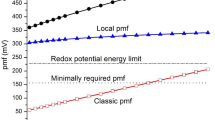Abstract
A transmembrane electron transport system has been studied in HeLa cells using an external impermeable oxidant, ferricyanide. Reduction of ferricyanide by HeLa cells shows biphasic kinetics with a rate up to 500 nmoles/min/g w.w. (wet weight) for the fast phase and half of this rate for the slow phase. The apparentK m is 0.125 mM for the fast rate and 0.24 mM for the slow rate. The rate of reduction is proportional to cell concentration. Inhibition of the rate by glycolysis inhibitors indicates the reduction is dependent on glycolysis, which contributes the cytoplasmic electron donor NADH. Ferricyanide reduction is shown to take place on the outside of cells for it is affected by external pH and agents which react with the external surface. Ferricyanide reduction is accompanied by proton release from the cells. For each mole of ferricyanide reduced, 2.3 moles of protons are released. It is, therefore, concluded that a transmembrane redox system in HeLa cells is coupled to proton gradient generation across the membrane. We propose that this redox system may be an energy source for control of membrane function in HeLa cells. The promotion of cell growth by ferricyanide (0.33–0.1 mM), which can partially replace serum as a growth factor, strongly supports this hypothesis.
Similar content being viewed by others
References
Berg, H. C. (1969).Biochim. Biophys. Acta 183 65–78.
Bienfait, H. F., Duivenvoorden, J., and Verkerke, W. (1982).J. Plant Nutr. 5 451–456.
Christensen, H. N. (1979).Advances in Enzymology and Related Areas of Molecular Biology (Meister, A., ed.) Vol. 49, Wiley, New York, pp. 41–101.
Clark, M. G., Partick, E. J., Patten, G. S., Crane, F. L., Löw, H. and Grebing, C. (1981).Biochem. J. 200 565–572.
Clark, M. G., Partick, E. J., and Crane, F. L. (1982).Biochem. J. 204 795–801.
Craig, T. A., and Crane, F. L. (1981).Proce. Indiana Acad. Sci. 90 150–155.
Crane, F. L., Goldenberg, H., Morre, D. J., and Löw, H. (1979).Subcellular Biochemistry (Roodyn, D. B., ed), Vol. 6, Plenum Press, New York, pp. 345–399.
Crane, F. L., Roberts, H., Linnane, A. W., and Löw, H. (1982a).J. Bioenerg. Biomembr. 14 191–205.
Crane, F. L., Crane, H. E., Sun, I. L., MacKellar, W. C., Grebing, C., and Löw, H. (1982b).J. Bioenerg. Biomembr. 14 425–433.
Crane, F. L., Sun, I. L., Löw, H., and Clark, M. G. (1983a).Hoppe-Seylers Z. Physiol. Chem. 354 1112.
Crane, F. L., Craig, T. A., Misra, P. C., and Barr, R. (1983b).Proc. Plant Growth Regul. Soc. Am. 10 70–74.
Dormandy, T. L., and Zarday, Z. (1965).J. Physiol. 180 684–707.
Ellem, K. A. O., and Kay, G. F. (1983).Biochem. Biophys. Res. Commun. 112 183–190.
Gerson, D. F., Kiefer, H., and Eufe, W. (1982).Science 216 1009–1010.
Goldenberg, H. (1982).Biochim. Biophys. Acta 694 203–223.
Goldenberg, H., Crane, F. L., and Morré, D. J. (1979).J. Biol. Chem. 254 2491–2498.
Hutchings, S. E., and Sato, G. H. (1978).Proc. Natl. Acad. Sci. USA 75 901–904.
Löw, H., and Werner, S. (1976).FEBS Lett. 65 96–98.
Löw, H., Crane, F. L., Grebing, C., Hall, K., and Tally, M. (1979). InDiabetes (Waldhäusl, W. K., ed.), Excerpta Media, Amsterdam, pp. 209–213.
Löw, H., Grebing, C., and Crane, F. L. (1982). Abstr. 12th Intern. Biochem. Congr. Perth, p. 138.
Manyai, S., and Szekely, M. (1954).Acta Physiol. Acad. Sci. Hung. 5 7–18.
Martonosi, A. (1982), ed.,Membranes and Transport Plenum Press, New York, vols. 1 and 2.
Mishell, B. B., and Shrigi, S. M. (1980), eds.,Selected Methods in Cellular Immunology W. H. Freeman, San Francisco, pp. 17–18.
Mishra, R. K., and Passow, H. (1969).J. Membr. Biol. 1 214–224.
Passow, H. (1963).Cell Interface Reaction (Brown, H. D., ed.) Scholars Library, New York pp. 57–67.
Romheld, V., and Marschner, H. (1983).Plant Physiol. 71 949–954.
Sun, I. L., Crane, F. L., Chou, J. Y., Löw, H., and Grebing, C. (1983).Biochem. Biophys. Res. Commun. 116 210–216.
Tökes, Z. A., Rogers, K. E., and Rembaum, A. (1982).Proc. Natl. Acad. Sci. USA 79 2026–2030.
Tritton, T. R., and Yee, G. (1982).Science 217 248–250.
Author information
Authors and Affiliations
Rights and permissions
About this article
Cite this article
Sun, I.L., Crane, F.L., Grebing, C. et al. Properties of a transplasma membrane electron transport system in HeLa cells. J Bioenerg Biomembr 16, 583–595 (1984). https://doi.org/10.1007/BF00743247
Received:
Revised:
Issue Date:
DOI: https://doi.org/10.1007/BF00743247




